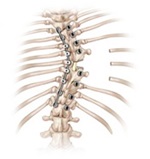Scoliosis Center
Scoliosis is a multi-faceted disorder that has both neurological and orthopedic implications resulting from an irregular curve of the spine or backbone. Normally, the spine has curves when looking at it from the side; however, it should appear straight when looking at it from the front. The spine of an individual with typical scoliosis may look more like an "S" or a "C" rather than a straight line.


The Scoliosis Center at St. Joseph’s Children’s Hospital we have an extensive, multi-disciplined team that provides treatment for:
- Idiopathic scoliosis: a curvature of the spine that usually occurs in children age 10 to maturity, but can occur in younger children or infants
- Neuromuscular scoliosis: also a curvature of the spine, but with a disorder of the neurological system such as cerebral palsy, spina bifida, muscular dystrophy or spinal cord injuries
- Congenital scoliosis: a curvature of the spine that results from anomalies or abnormally developed vertebrae, which are the building blocks of the spinal column
Who gets scoliosis?
Scoliosis can first appear in young children or even infants, but most often it shows up during middle to late childhood -- a time when the spine and the rest of the body go through a growth spurt. Girls are more likely than boys to develop idiopathic scoliosis.
What are the signs of scoliosis?
One or both shoulder blades may be elevated, the waist may be lopsided, the hips may seem unusually high or the child may lean to one side. Additionally, a rib prominence (hump) may be seen from the back when the child bends forward.
Additional Resources
What causes scoliosis?
In most cases, scoliosis arises for no apparent reason; this is called idiopathic scoliosis. Occasionally, scoliosis is the result of an illness, birth defect (such as cerebral palsy) or a malformation of part of the spine during pregnancy; this is called congenital scoliosis.
What are the suggested treatments for scoliosis?
- Monitoring
Some curves of the spine are mild and do not require treatment, but do need to be monitored periodically by examination and X-rays to ensure they don't worsen. - Non-operative (brace or wheelchairs)
We measure the spinal curves in degrees. If a curve is fairly large (between 20 degrees and 40 degrees) and a child is still growing, we may recommend a brace to keep the curve from getting any worse. For children with neuromuscular scoliosis, we may suggest a custom wheelchair to help improve sitting posture. - Operative (surgery)
Scoliosis surgery is one of the most extensive and complex orthopedic surgical procedures performed on children. However, recent advancements have improved the success and safety of these surgical procedures, and new surgical technology has eliminated the need for braces after surgery. Typically, the operation takes approximately four to six hours, and hospitalization can last several (usually around six) days. Activities are restricted for several months.
Types of Surgical Procedures
Spinal Fusion - Spinal fusion surgery may be recommended for a child who is done growing to correct the curvature and stabilize the spine. Although fusions in adults may not fully relieve symptoms and can create additional problems, this is usually not the case in the treatment of pediatric scoliosis.
This surgery fuses vertebrae in the spine together using instrumentation and bone grafts. Metal rods and screws are used to hold the curved bones in a straight position, Bone grafts are then packed around the abnormal vertebrae and will eventually fuse together with the spine, straightening it.
Selective Fusions - The goal of these procedures is to fuse the smallest possible number of vertebrae and to leave as many mobile spinal segments as possible to maintain maximum mobility. The most common method of the surgery performed to treat early onset scoliosis requires insertion of a distraction instrumentation system. The surgery typically consists of one fusion at the top of the scoliosis curve and another at the bottom of the spine deformity with rods placed in-between, avoiding fusion of the entire spine. The fused areas are usually not the most deformed or rotated portions of the spine. The procedure requires distraction every 6 months in attempt to mimic natural growth of the non-fused levels beneath the subcutaneous rods. This type of procedure requires multiple visits to the operative room.
Shilla - Shilla implants are rods that are attached to screws along the spine, allowing the spine to continue to grow on its own. This cutting-edge procedure allows for natural growth of the spine and correction of the spine at the same time. In this procedure, only 2-4 levels of the most deformed segments of the spine, are fused. This is followed by the placement of long rods on both sides of the spine. At the fusion levels, the rods are fixated securely but attached at the top and bottom of the scoliosis curve, usually with screws, that do not lock onto the rods. Therefore, growth of the spine still occurs, except at the fused areas, guided by the rods. This method of guided growth limits repetitive surgical procedures.
MAGEC - MAGEC rod implantation is an innovative option to treat certain types of early onset scoliosis. A recent advancement, these rods use magnet technology which allows them to be lengthened remotely. This eliminates the needs for repetitive surgeries.
However, once the young spine has achieved spinal growth and lung development has occurred definitive spinal fusion is likely required.
Call us at (813) 554-8983 to make an appointment or discuss concerns you may have regarding your child's spine. We have a full team of specialists ready to address your concerns.
